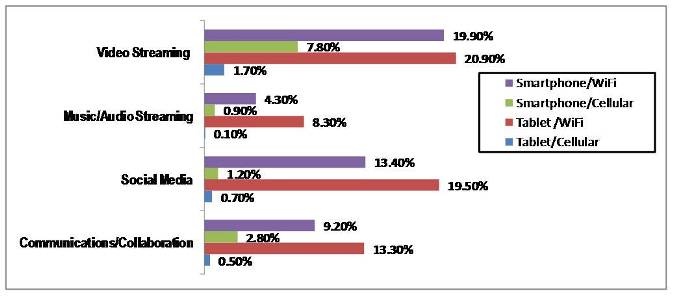Mobile Video's Boom Will Impact Broadcasters and Cable

Mobile video - now topping 50% of data traffic on wireless networks - will consume nearly three-quarters of wireless capacity before decade's end, according to Cisco's latest Visual Network Index. That represents a 13-fold increase from 2014 to 2019 in wireless video, with much of it moving to WiFi delivery, Cisco predicts.
The appetite for wireless video consumption has significant implications for cable's "TV Everywhere" initiatives as well as for broadcasters' nascent ATSC 3.0 plans, including their strategies in the upcoming incentive spectrum auctions.
Cisco's report was well-timed last week, coinciding with promises from Verizon CEO Lowell McAdam that pay TV will be a major driver for Verizon's 4G LTE networks. He cited Verizon's recent technology acquisitions that will accelerate its wireless pay TV introduction, but did not specify a timetable.
Cisco's VNI also presented a roadmap for greater voice-over-WiFi, which Jeff Baumgartner pinpointed in his assessment of the Cisco forecast, tying the VoWiFi outlook to Cablevision's recently announce plans for that service.
Collectively, Cisco's study plus ventures such as those planned by Cablevision, Verizon and others suggest a world of more competition -- in the marketplace on the airwaves.
Cisco's annual VNI "Global Mobile Data Traffic Forecast" comes as a prelude to next month's World Mobile Congress, where new wireless applications dominate the dialogue, with video as a key ingredient. The study notes that mobile video traffic exceeded 50% of all mobile data for the first time in 2012. In 2014, it was 55% of total data use. By 2019, video will account for 72% of wireless traffic, Cisco says.
Most significantly, Cisco expects that, "More traffic will be offloaded from cellular networks [to WiFi] than remains on cellular networks by 2016."
The study finds that WiFi is already dominating cellular network usage in several key app categories (see chart) and that tablets are outpacing smartphones as the platform for mobile data traffic. For example, video streaming on WiFi to tablets accounts for nearly 21% of mobile data and about 20% of the data load to smartphones. In comparison, cellular networks carry barely 8% of data for video streams to smartphones and less than 2% to tablets.
Multichannel Newsletter
The smarter way to stay on top of the multichannel video marketplace. Sign up below.
Contributor Gary Arlen is known for his insights into the convergence of media, telecom, content and technology. Gary was founder/editor/publisher of Interactivity Report, TeleServices Report and other influential newsletters; he was the longtime “curmudgeon” columnist for Multichannel News as well as a regular contributor to AdMap, Washington Technology and Telecommunications Reports. He writes regularly about trends and media/marketing for the Consumer Technology Association's i3 magazine plus several blogs. Gary has taught media-focused courses on the adjunct faculties at George Mason University and American University and has guest-lectured at MIT, Harvard, UCLA, University of Southern California and Northwestern University and at countless media, marketing and technology industry events. As President of Arlen Communications LLC, he has provided analyses about the development of applications and services for entertainment, marketing and e-commerce.

